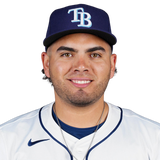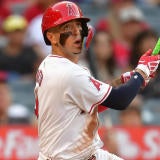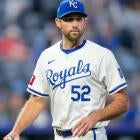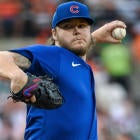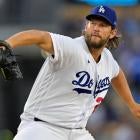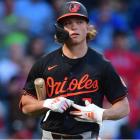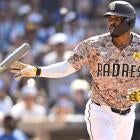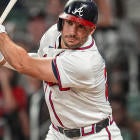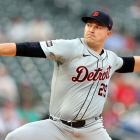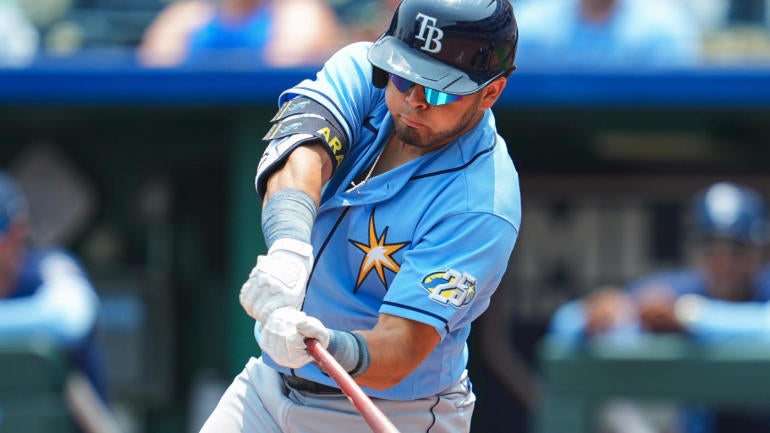
We should all be turning cartwheels right now. We should be sliding down the banisters and swinging from the chandeliers with the news that Jonathan Aranda -- i.e., Mickey Mantle incarnate -- is in the major leagues.
You tell me I'm exaggerating. Am I, though? OK, probably. But I want to emphasize probably. With numbers like these at Triple-A Durham, I've come to believe the sky's the limit for what Aranda can accomplish as a hitter:
| ||||||||||||
And the surface-level stats, for the incredible story they tell, don't tell the whole story. He just wrapped up a four-game stretch in which he hit .529 (9 for 17) with five home runs. It continued a 53-game stretch in which he hit .391 (81 for 207) with 18 home runs. "Ah, you say, but isn't that in the minor leagues, with their Chuck E. Cheese ballparks and whack-a-mole pitchers?" Well, to those with a more sophisticated palate, allow me to point out his 92.3 mph average exit velocity, which is comparable to Austin Riley. Allow me to point out his 113 mph max exit velocity, which is comparable to Corey Seager. Allow me to point out his 14.7 percent walk rate and 20.0 percent strikeout rate, which are comparable to Lars Nootbaar. (Wait, Nootbaar? Is that so impressive? For a player with Riley's and Seager's exit velocities, it is!)
And for those who can't tolerate numbers of any kind, allow me to direct your gaze to something beyond beautiful:
Goodness, Jonathan Aranda! 464 feet?!
— Minor League Baseball (@MiLB) July 30, 2023
The @RaysBaseball second baseman just WALLOPS his 19th homer of the year for the @DurhamBulls: pic.twitter.com/NlIy6XHVXh
That, ladies and gentlemen, is a majestic home run.
And that, as in all of that, is why I struggle to put limitations on Aranda as a hitter. He won't steal bases, I guess, but nobody will care if he does all that other stuff.
Here, though, is why we're not turning cartwheels, sliding down banisters and swinging from chandeliers: he was already up this year. He was up last year, even. And you know what? It didn't amount to much.
The Rays, man ... they hate us. Amid their myriad lineup changes, their excessive platoons and their steadfast refusal to adhere to any of the pitching conventions around which our game is designed, there's no clearer evidence of their disdain for Fantasy Baseballers than the fact they've left Aranda to stew in the minors at age 25, never giving him honest chance until ... what, now?
Well, he wasn't in the lineup Tuesday -- against a right-hander, I might add. The Rays don't really need him at first or second base, and those are the only positions he plays. His defensive limitations are part of the reason he's been passed over for so long, but where there's a DH spot, there's hope. I don't trust this organization to have his or our best interests in mind, but I do want to grab Aranda anywhere I can just in case.
Because the sky, I repeat, is the limit.
Five on the verge
(These are the prospects most worth stashing in redraft leagues.)
Michael Busch, 2B, Dodgers
2022 minors: .274 BA (552 AB), 32 HR, .881 OPS, 74 BB, 167 K
2023 minors: .321 BA (336 AB), 23 HR, 1.042 OPS, 59 BB, 78 K
Perhaps Busch can follow Aranda back to the majors. They've been joined at the hip as 25-year-olds who've gotten only cursory glances in the majors despite straight-up murdering minor-league pitching. As with Aranda, defensive limitations likely have something to do with it -- Busch isn't a great fit at either second or third base -- and perhaps it says something that the Dodgers have started giving him looks in left field. But in the end, hitters are there to hit, and he's done that better than ever since his last stint with the big club, batting .331 (53 for 160) with 16 homers and a 1.124 OPS in just 38 games. His exit velocity readings are exceptional, his on-base skills inimitable. Whenever his chance does come, good things are likely to result from it.
Edward Cabrera, SP, Marlins
2023 majors: 5-6, 4.79 ERA, 1.47 WHIP, 77 IP, 52 BB, 93 K
2023 minors: 2-0, 1.50 ERA, 0.67 WHIP, 12 IP, 3 BB, 13 K
One of the rules of my Prospects Report is that I'm happy to discard the rules whenever it suits my purpose. The spirit of my Five on the Verge is to highlight players who may be worth stashing even while they're out of sight and out of mind, which sometimes means a minor-leaguer who hasn't technically been a prospect in a couple years. That's the case for Cabrera, who struck out 10 over six one-hit innings in his latest start for Triple-A Jacksonville. We already know what he's capable of doing for Fantasy. He had a 12-strikeout effort in the majors this year. He had a 10-strikeout effort in the majors this year. He had way too many walks in between. So far, he's walked just three in 12 innings for Jacksonville, throwing 66 percent of his pitches for strikes, which could get him back to the majors in short order.
"When you're watching him, he's commanding all of his pitches again, which is what we're looking for," manager Skip Schumaker said. "Hopefully he continues to do that. If he continues to do that and knock the door down, he'll come back up."
There isn't a single pitching prospect right now who's prepared to make the sort of impact Cabrera could, nor is there one who has as easy of a path to the majors. So if you're going to stash any minor-league pitcher right now, he's the one.
Masyn Winn, SS, Cardinals
2022 minors: .283 BA (474 AB), 12 HR, 43 SB, .832 OPS, 63 BB, 115 K
2023 minors: .284 BA (437 AB), 17 HR, 17 SB, .823 OPS, 43 BB, 81 K
Winn is back from the mild glute strain that cost him just a handful of games, as expected, and back on the path to getting a September call-up as the Cardinals evaluate their personnel for 2024. Why wait until then? They want to keep his rookie status intact for next year. If he's on the roster from start to finish and places high enough in Rookie of the Year voting, it could score the team an extra draft pick. Them's the rules as of the latest CBA.
Seventh triple for Masyn Winn this year. SEVEN! pic.twitter.com/AnXVAdVtUy
— Memphis Redbirds (@memphisredbirds) August 16, 2023
Power has always been the most questionable part of Winn's skill set, but nine of his home runs have come in his past 26 games, during which he's batted .352 (37 for 105). I said last week that I thought he could bring Randy Arozarena-like production to the shortstop position, and I'm sticking with that assessment.
Ceddanne Rafaela, OF, Red Sox
2022 minors: .299 BA (481 AB), 21 HR, 28 SB, .880 OPS, 26 BB, 113 K
2023 minors: .304 BA (398 AB), 18 HR, 34 SB, .871 OPS, 22 BB, 91 K
As the Red Sox have fought to remain in the AL wild card race, one area where they've come up a little bit short is center field defense, having to make do with Jarren Duran and Adam Duvall out there. No doubt, they value them as hitters, but they would be better served shifting them to left and having Masataka Yoshida play DH. And then they could bring up a true center field standout in Rafaela, who, by the way, is no slouch offensively. He has only seen his numbers improve, in fact, since moving up to Triple-A in late June, and over his past 29 games, he's batting .358 (43 for 120) with 10 homers and a 1.146 OPS.
Whether or not he gets the call depends on a couple factors, one being how the Red Sox think he's progressing with his swing decisions. He's always been an aggressive hitter. The other is what happens with Justin Turner, who's currently playing with a bone bruise in his heel. If it confines him to DH rather than letting him man second base, then maybe the Red Sox won't be able to reshuffle their outfield as needed.
Brett Baty, 3B, Mets
2023 majors: .216 BA (278 AB), 7 HR, .620 OPS, 27 BB, 86 K
2023 minors: .364 BA (55 AB), 8 HR, 1.317 OPS, 10 BB, 15 K
Like Cabrera, Baty technically isn't a prospect anymore, but like Cabrera, I can't come up with five actual prospects who are more stashable. Sure, his first shot at holding down the third base job didn't go well, which is why he wound up back in the minors, but Mark Vientos isn't making anyone forget about him. Meanwhile, Baty has gone down and hit .300 (6 for 20) with three homers and a double in five games. A little boost in confidence might help him to find his footing when he inevitably returns. If nothing else, you have to expect the Mets will go back to Baty before they try out Ronny Mauricio, who's batting .237 (53 for 224) since the start of June.
Five on the periphery
(Here are some other prospects doing something of note.)
Owen Caissie, OF, Cubs
2022 minors: .254 BA (378 AB), 11 HR, 11 SB, .751 OPS, 50 BB, 124 K
2023 minors: .289 BA (357 AB), 21 HR, 6 SB, .935 OPS, 56 BB, 136 K
In the years since coming over from the Padres in the Yu Darvish trade, Caissie has been one of those prospects whose attributes stand out over his production, but the latter is beginning to measure up to the former. His first few months at Double-A Tennessee were defined mostly by strikeouts, and he still has higher than a 30 percent rate overall. But he's gotten it down to 20.8 percent over his past 16 games, batting .390 (23 for 59) with five homers, a triple and seven doubles during that time. It's a small sample, but small samples can be more meaningful for players in the throes of development. It also gives us a chance to focus on the good for once, namely his prodigious power.
Pedro Leon, OF, Astros
2022 minors: .228 BA (413 AB), 17 HR, 38 SB, .796 OPS, 71 BB, 145 K
2023 minors: .266 BA (380 AB), 20 HR, 14 SB, .836 OPS, 42 BB, 123 K
Already a standout in Cuba, Leon signed a big bonus with the Astros in 2020 and has had no shortage of admirers since then even though the production has left much to be desired. He may make believers of all of us before all is said and done, though. Over his past 22 games, he's batting .326 (30 for 92) with eight homers, four steals and a 1.020 OPS. You could argue it's not enough to turn the tide for a 25-year-old repeating Triple-A, and hey, fair enough. But Leon is capable of contributing in a wide enough variety of ways -- drawing walks, stealing bases, etc. -- that he merely needs to keep his head above water at the plate. He could be James Outman-like if he gets the chance.
Drew Thorpe, SP, Yankees
2023 minors: 11-2, 2.62 ERA, 1.02 WHIP, 117 IP, 33 BB, 147 K
Seems like I'm writing about Thorpe every other week, but the first-year pro again deserves special distinction for his Double-A debut in which he struck out nine and walked none over eight two-hit innings. It was his third start going eight innings or more and allowing two hits or fewer, which is something you hardly see in the minors amid all the workload restrictions, and yet he hasn't thrown more than 96 pitches in any one start.
Drew Thorpe (@Yankees' No. 5 prospect) was lights out in his Double-A debut for the @SOMPatriots:
— MLB Pipeline (@MLBPipeline) August 12, 2023
8⃣ IP
2⃣ H
0⃣ R
0⃣ BB
9⃣ K pic.twitter.com/GMlD5N8KtH
The efficiency speaks for itself at this point, but you shouldn't mistake Thorpe for a finesse pitcher considering his 11.3 K/9 rate and 18 percent swinging-strike rate. I had wondered if his success was mostly a matter of A-ball hitters not knowing what to do with his changeup, but if it continues into Double-A, he'll rocket up rank lists.
Wilyer Abreu, OF, Red Sox
2022 minors: .247 BA (457 AB), 19 HR, 31 SB, .834 OPS, 114 BB, 153 K
2023 minors: .268 BA (284 AB), 20 HR, 6 SB, .898 OPS, 53 BB, 73 K
Diminutive second baseman Enmanuel Valdez got most of the attention in the deal that sent Christian Vazquez to the Astros last year, but Abreu may prove to be the more impactful piece. Like Valdez, his power plays beyond his size, thanks in large part to his ability to elevate the ball, and the clearest evidence for this was his three-homer game Sunday. In all, he's batting .539 (14 for 26) with six homers in his past seven games. All those fly balls lead to more outs on contact -- otherwise known as a low BABIP -- but he makes up for it with superlative on-base skills, having reached at a .380 clip this year. He may ultimately peak as a fourth outfielder, but at 24, he's close to getting his chance.
Christian Scott, SP, Mets
2022 minors: 3-3, 4.45 ERA, 1.41 WHIP, 58 2/3 IP, 22 BB, 77 K
2023 minors: 5-4, 2.71 ERA, 0.86 WHIP, 83 IP, 12 BB, 99 K
Scott came into the year in prospect obscurity, perhaps because he had been a reliever heretofore. But his transition to the rotation has gone gangbusters, and most of the prospect evaluation world hasn't caught on yet. His last outing at Double-A saw him allow just two baserunners (one on a hit and one on a hit by pitch) in 6 1/3 innings, and in his last five starts, he has 37 strikeouts to just one walk over 28 innings, good for a 1.93 ERA. His strike rate during that stretch is 71 percent, and his swinging-strike rate is 19 percent. Among qualifying major-leaguers, only George Kirby compares to that first number and only Spencer Strider to that second number.
As a converted reliever, Scott is still fleshing out his secondary arsenal, but it's clear he has the basics of pitching down and, at 24, could get a look with the big club soon.



